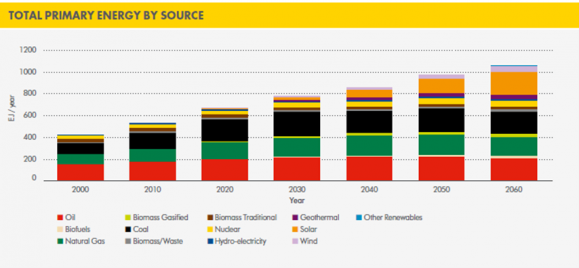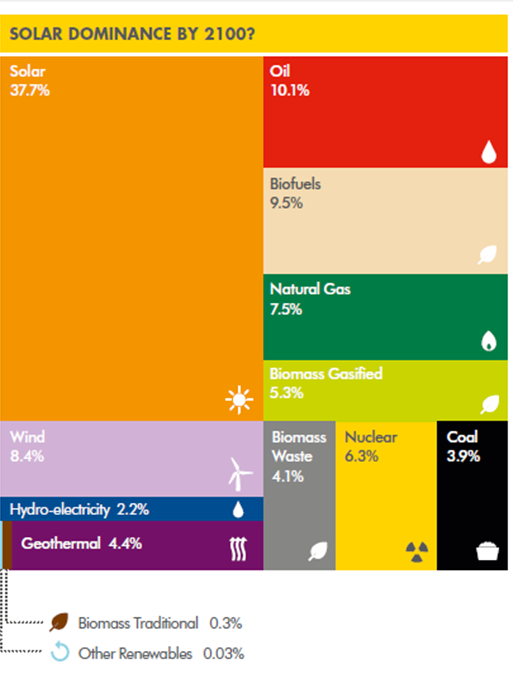Shell-scenario sees dramatic growth in solar PV
We need new lenses to orient ourselves in a world of global paradoxes, increasing pressure on natural resources and declining support for established institutions.
That is why the oil company Shell has resumed the tradition of developing and presenting long term global scenarios. The new scenarios presented Febr 28 are called «New Lens Scenarios – a shift in perspectives for a world in transition», and can be downloaded here.
«These scenarios show how the choices made by governments, businesses and individuals in the next few years will have a major impact on the way the future unfolds,” Chief Executive Officer Peter Voser said in a statement, according to Bloomberg.
The scenarios provide some fascinating ideas and insights in the areas of economics, institutions and social development. Seen from my point of view I find it most astonishing that Royal Dutch Shell, which left the solar market four years ago, now says in one of its two scenarios that solar PV will grow to be the world’s largest source of primary production by 2060.
The report draws two different scenarios for developments over the next 50 years:
“Mountains”: Natural Gas, Hydrogen
In “Mountains”, it is the major nation-states, particularly the United States and China, and the established elites and businesses that largely retain control in society. “The New Gilded Age” is used to describe a development marked by growing inequality, partly caused by the increasing division between those who have the right diplomas and those who have not.Energy demand continues to grow, but growth is slowing faster than expected due to lower economic growth.
In “Mountains” exploitation of Natural Gas is the fastest growing energy source until reserves decline and climate crisis becomes acute in the middle of the century. In 2040, Natural Gas holds the largest share of total primary energy demand, exceeding both oil and coal. The Shale gas revolution spreads from the U.S. to China, India, South Africa, Latin America and even Europe. The gas boom is further reinforced by extraction of Methane Clathrates from the seabed. In power generation Natural Gas replaces Coal on a large scale, and it takes a large share from Oil in the transport sector. The latter occurs first through gas-powered vessels, buses and cars, but primarily by a large-scale development of infrastructure for Hydrogen. Abundant gas resources are used to produce large amounts of Hydrogen, applied via large diffusion of Fuel cells. By 2060, the “Hydrogen-society” is resurrected from the failed “hype of the 1990s, as a “bird Phoenix”.
In the “Mountains” scenario production and distribution of energy develop as follows:

“Oceans”: Decentralization, Solar explosion
Scenario 2, “Oceans”, is characterized by nationstates, elites and the established companies losing control. It is driven by the awakening of an increasingly vigorous civil society to challenge government and seek solution to problems that lie outside public control… The debate on climate change takes place between the older generation that has presided over the problem and a younger one that aspires to find solutions and reverse its potential impacts. The scenario is furthermore characterized by the emergence of IT-empowered ‘netizen’ communities:
“In an increasingly networked world, people power drives politics to set the terms within which markets operate and to bend the state to their will. The focus falls on individual and collective rights, which are upheld against the state, rather than on the individual’s responsibilities towards the state.”
In the field of energy, this scenario is characterized by relatively high oil and energy prices. The Natural Gas optimism that was so prevalent before 2020 did not meet expectations. Admittedly, gas increased its market share, but not as in “Mountains”. This results in coal retaining its leadership position in a yet a few decades, combined with a high growth in renewable energy and energy efficiency. The Shell team is particularly optimistic about the potential for generating electricity from solar energy. With rising energy prices and falling costs of storage and technology innovation, we will see an explosion in households that are self-powered. In 2060 nearly 60 percent of the power supply in Asia, Africa and Latin America – and 40 % of global production – will come from solar PV, according to this scenario.
Although the global capacity of solar energy has grown from modest 1 GW in 2000 to over 100 today, it is still far less than 1% of total power generation. Shall it grow to more than 40 % as Shell suggests, also taking into account that total world consumption will be seven times higher by end of century, the PV industry must become more than 300 times larger than it is today.
The table below summarizes developments in the energy mix according to the “Oceans” scenario:

By the end of the century the Shell planners envision that solar energy will represent the 37,7% of primary energy production, compared to 10% for oil and 7.5% for natural gas.

Both scenarios are characterized by the increasing tension between sustainability and economic growth. As shown in the figure below: In the first half of the century, CO₂ emissions fail to curb as the 2 degree scenario requires. But after some decades characterized by global warming, the scenarios assume that the effects of extreme weather and natural disasters will be so severe that the world community is forced to adopt tougher measures.
In both scenarios Carbon Capture and Storage plays a critical role from the middle of the century. It leads to the global emissions of carbon dioxide falling to near zero by 2100. Gasoline powered cars are largely replaced by electric and hydrogen-powered vehicles.
Food for thought – and action
Let me add a personal note at the end: The man who first introduced scenarioplanning in Shell and inspired some of us to start using the method already in the 1980s, was the late Pierre Wack, a cosmopolitan French journalist who against all odds became Head of Planning department of the oil company Shell. I will never forget his story about how surprising but carefully scripted scenarios made the Shell management less unprepared than the competitors to meet the major upheavals in the Middle East in the 1970s.
The Shell team concludes by pointing out that both scenarios raise existential questions regarding sustainability and adaptability. They refer to the philosopher Schopenhauer, who “pointed out, new truths are first ignored or ridiculed, then vehemently opposed, and then, ultimately, taken to be self-evident.”
But Shell planners have obviously been keen not to scare.
“This work illustrates a hypothetical trajectory for greenhouse gas emissions, with potential disruptions resulting from climatic turbulence that will have an increasingly severe impact on global economic, social, and political conditions. Given uncertainties around potential developments in the longer term, it is not fruitful to build such dramatic feedback loops directly into the core scenarios. Instead we want to be clear about where the trajectories are heading and to support a betterinformed dialogue about the potential consequences.”
This insight is not new, but when it this time comes from the business environment team of one of the world’s largest oil companies, it provides additional food for thought. And, hopefully, action.
Follow me on Twitter: @OsmundsenTerje